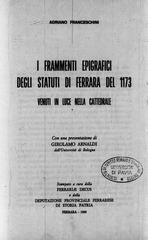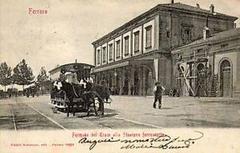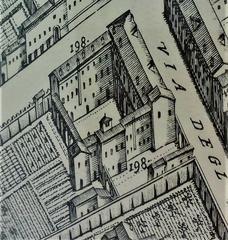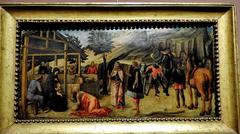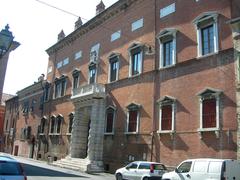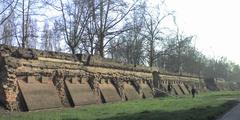Baluardo di Sant’Antonio: Visiting Hours, Tickets, and Complete Guide to Ferrara’s Renaissance Bastion
Date: 03/07/2025
Introduction
Nestled within Ferrara’s UNESCO-listed city walls, the Baluardo di Sant’Antonio is a striking example of late Renaissance military architecture. Characterized by its “ace of spades” (punta di diamante) design, this bastion reflects the city’s strategic innovations during the Este family’s rule. Constructed between the late 15th and 16th centuries, particularly during the “Addizione Erculea” of 1492 and subsequent modernization in the 1580s, it stands today as a preserved symbol of Ferrara’s rich cultural and historical legacy, seamlessly integrated with green spaces and cycling paths (Comune di Ferrara, Museo Ferrara, Ferrara Terra e Acqua, Ferrara Walls).
This guide offers detailed insights into the bastion’s history, architectural features, visitor information (including hours and accessibility), restoration efforts, and tips for exploring Ferrara’s broader heritage.
Table of Contents
- Overview and Historical Context
- Architectural Features and Construction
- Military Significance
- Restoration and Preservation
- Visiting Information: Hours, Tickets, Accessibility
- Special Events, Tours, and Photography
- Nearby Attractions and Travel Tips
- Conservation and Community Integration
- Frequently Asked Questions (FAQ)
- Conclusion and Final Tips
- References
Overview and Historical Context
Origins and Strategic Role
Commissioned under the Este dynasty, the Baluardo di Sant’Antonio was built as part of Ferrara’s ambitious “Addizione Erculea” expansion, reflecting advances in military engineering necessary to counteract gunpowder artillery. Military architects such as Biagio Rossetti contributed to the design, establishing Ferrara as a model of Renaissance urban fortification (Comune di Ferrara).
Cultural Significance
Beyond its military function, the bastion has shaped Ferrara’s urban identity. Its integration with the city’s green belt and public spaces has transformed it from a defensive structure into a vibrant community landmark (Ferrara Terra e Acqua).
Architectural Features and Construction
“Ace of Spades” Design
The bastion’s unique geometric form features a pointed tip and angled faces, maximizing defensive coverage and minimizing blind spots. Built mainly from robust Ferrara brick, the walls—up to 10 meters thick—could absorb and deflect artillery fire. The design responds directly to the challenges of 16th-century siege warfare (Museo Ferrara, Ferrara Terra e Acqua PDF).
Integration with the Environment
Strategically positioned near the Monastery of Sant’Antonio in Polesine, the bastion commands views of the Po River and historically vulnerable southern approaches. Today, the surrounding landscape features walking and cycling paths, offering panoramic views and leisure opportunities (Ferrara Terra e Acqua PDF).
Military Significance
The Baluardo di Sant’Antonio, together with the Baluardo dell’Amore and Baluardo di San Pietro, formed a defensive network along Ferrara’s southern perimeter. Its overlapping fields of fire created formidable barriers against attacks, particularly during conflicts such as the War of the League of Cambrai and later disputes with the Papal States (Enciclopedia Treccani). Its design exemplifies the “trace italienne” fortification, with thick, sloped walls and angular protrusions (Ferrara Terra e Acqua PDF).
Restoration and Preservation
Recent Restoration Efforts
Starting in the late 19th century and intensified in recent decades, restoration projects have addressed structural subsidence, brick deterioration, and invasive vegetation. The most recent consolidation, completed in 2025, stabilized the masonry, improved drainage, and restored the bastion’s original appearance (AgenziaCULT).
Conservation Challenges
Interventions in the 20th century, such as road widening (1967) and the planting of a poplar grove (1981), have altered the bastion’s visibility and structure. Modern restoration balances ecological value with architectural authenticity, using traditional materials and sustainable vegetation management (Antica Ferrara, Il Resto del Carlino).
Visiting Information: Hours, Tickets, and Accessibility
- Hours: Open year-round, typically from sunrise (~7:00 AM) to sunset (~8:00 PM in summer). Hours may vary in winter or during special events; check Ferrara Terra e Acqua for updates.
- Tickets: Admission is free. No ticket booths; self-guided access is encouraged.
- Accessibility: Main paths are paved and generally suitable for wheelchairs and strollers, though some historic surfaces and steps may be challenging. Contact the Ferrara tourism office for detailed accessibility support.
- Facilities: While there are no on-site restrooms or cafés, nearby parks and the Monastery of Sant’Antonio in Polesine offer amenities.
Special Events, Tours, and Photography
- Guided Tours: Available through local heritage associations and during cultural projects such as “Un chilometro di mura all’anno” (Cronaca Comune).
- Events: The bastion occasionally hosts heritage festivals and educational activities; check local listings.
- Photography: The site offers excellent viewpoints for capturing Ferrara’s cityscape, especially during golden hour.
Nearby Attractions and Travel Tips
- Location: Adjacent to the Monastery of Sant’Antonio in Polesine; accessible via Via Quartieri and Via Gramicia.
- Transportation: Reachable by foot (20 minutes from Ferrara railway station), by bicycle (rentals available citywide), or by car with parking outside the historic center.
- Nearby Sights: Combine your visit with the Castello Estense, Palazzo dei Diamanti, the Cathedral, and the extensive city walls (The Crazy Tourist, Komoot).
Conservation and Community Integration
- Restoration Campaigns: The “Un chilometro di mura all’anno” initiative funds ongoing maintenance and public engagement (Cronaca Comune).
- Community Value: The bastion is a focal point for local identity, educational programs, and urban green space.
- Sustainability: Restoration methods prioritize traditional materials, minimal chemicals, and collaboration with heritage experts.
Frequently Asked Questions (FAQ)
Q: What are the visiting hours?
A: The site is open daily from sunrise to sunset. Confirm seasonal variations with the Ferrara tourism office.
Q: Is there an entrance fee?
A: No, access is free.
Q: Is the site accessible for wheelchairs?
A: Most main paths are accessible, but some surfaces are uneven. Contact visitor services for the latest updates.
Q: Are guided tours available?
A: Yes, through local organizations; booking is recommended for groups or special events.
Q: Can I visit other attractions nearby?
A: Yes. The bastion is near Ferrara’s major historical sites, making it ideal for a full day of exploration.
Conclusion and Final Travel Tips
The Baluardo di Sant’Antonio stands as a testament to Ferrara’s Renaissance ingenuity and ongoing conservation commitment. Its innovative design, strategic role, and integration with modern urban life make it an essential stop for any visitor. Thanks to recent restoration, the bastion is safe, accessible, and visually compelling.
Travel Tips:
- Visit in spring or autumn for the best weather and light.
- Wear comfortable shoes for uneven terrain.
- Enhance your experience with a guided tour.
- Respect conservation signage and stay on marked paths.
For up-to-date information, download the Audiala app, check the Ferrara tourism website, and explore related articles about Ferrara’s city walls and heritage events.
